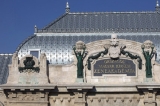Budapest is looking forward to the reopening of Liszt Academy’s Concert Centre on the 22nd October. An International press conference and a Grand Opening Gala will be the highlights of the day. With the conclusion of reconstruction work on the palace of music on Liszt Square, which reopens in all its original glory on 22 October 2013, the institution of the academy is also renewed. From now on, the university of music and musicology forms a dual entity with a concert organization. Built in Art Deco style, the Liszt Academy becomes a concert centre organizing its own programmes. There exist only a few comparable examples of such integration in international music. A global brand is being built and it was quite a challenge to find a consensus on a common name.
The Budapest Liszt Ferenc Academy of Music is outstanding from several aspects: its founder is Ferenc Liszt, and in the wake of an initiative of Zoltán Kodály it offers not only music training but musicology courses as well, and what is more, to the very highest (doctoral) level.
In 1875 the institution was formally titled the National Hungarian Royal Academy of Music, and this name was inscribed in the facade of the building on Liszt Ferenc Square, which was inaugurated in 1907.
Logically, the Art Nouveau palace of music took on the name of the institution. In 1918, both the ‘Royal’ and ‘Academy’ were dropped: the minister of religion and education authorized the academy of music to bear the title National Hungarian College of Music, which then took on the name of Ferenc Liszt on its fiftieth anniversary, in 1925.
Although up until the reconstruction work started in 2011 the facade of the building still displayed Liszt Ferenc College of Music, the situation was further complicated by the fact that the institution was awarded university status in 1971, and only 30 years later did the name Liszt Ferenc University of Music become commonly applied, while the principal concert venue continues to be called the Zeneakadémia (literally, Academy of Music) by the Hungarian public (in English, the concert venue is called the Liszt Academy). In the meantime, students refer to their Alma Mater with the abbreviations LFZE (standing for Liszt Ferenc University of Music), official usage in the tertiary admissions system, or the deeply entrenched ZAK (for Academy of Music).
With the further expansion and growth of the Liszt Academy, the problematic naming now no longer concerns only the totally renewed building on Liszt Ferenc Square, colloquially known as the Academy of Music by the concertgoing public, and the university of music that operates within it.
The naming has grown to become a key issue fundamentally determining the identity of the uniquely varied cultural citadel integrating a dozen other venues and institutes – including the Liszt Museum, Kodály Institute, and even the Ligeti György building – and also functioning as an independent concert centre from 2013.
In May 2013 the university senate decided, with due consideration to the need to retain the ‘brand name’ deeply etched in the public mind, to go with the Hungarian, short and practical Zeneakadémia (Academy of Music), although only the English version of this, Liszt Academy, refers to the founder, as the primary title. The full formal name of the institution, used for protocol purposes only, is changed to Liszt Ferenc Zeneművészeti és Zenetudományi Egyetem, Koncertközpont (Liszt Ferenc Academy of Music and Musicology, Concert Centre), while the section with rights for the organization of public concerts, independent programme making and sales will, according to plans, shortly be a separate legal entity, albeit operating in nonprofit corporate form in 100% ownership of the university, as the Liszt Academy Concert Centre.
























